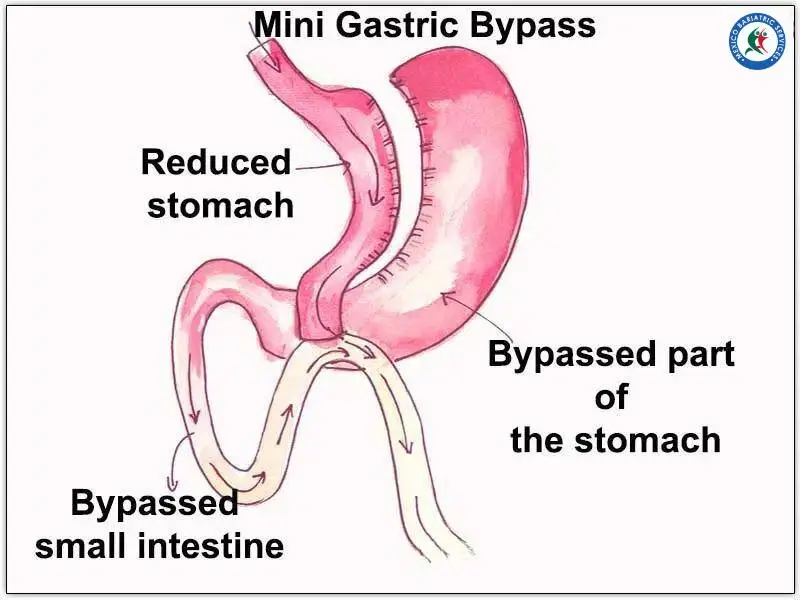Mini Gastric Bypass in Mexico Complete Guide: Cost, Process, and Benefits
Discover affordable mini gastric bypass in Mexico and save up to 70% compared to the US. Check out patient reviews, costs, all-inclusive packages, and the journey below. Scroll down for more details!
It’s normal to have questions, especially about what to expect. Reading happy reviews from other patients can help calm your worries.
Patient Reviews of Mini Gastric Bypass in Mexico
Explore the reviews below from our happy patients who underwent mini gastric bypass surgery in Mexico!
Below, you’ll find remarkable transformations. Take a look!
Mini Gastric Bypass in Mexico: Before and After
Check out Gabriel Ramos, who lost 320 lbs with mini gastric bypass surgery in Mexico, and Ayram González with amazing transformations below!


Are you worried about the cost of a mini gastric bypass? Weight loss surgery in Mexico is much more affordable than in the US.
Take a look at the prices to see for yourself!
How Much Does a Mini Gastric Bypass Cost in Mexico?
In the United States, a mini gastric bypass generally costs approximately $16,000- $22,000. However, Mexico provides an attractive offer where the cost ranges between $5,299 and $6,995. Going south of the border for surgery can help you save about 70% of US prices.
Check out the cost comparison between Mexico and the US below!
Mini Gastric Bypass Cost in Mexico vs the US
| Mexican Cities | Cost in Mexico | Cost in the US |
|---|---|---|
| Tijuana | $5,495 | $22,000 |
| Cancun | $6,995 | $22,000 |
| Nuevo Laredo | $6,599 | $22,000 |
| Reynosa | $5,299 | $22,000 |
| Puerto Vallarta | $6,900 | $22,000 |
| Guadalajara | $6,630 | $22,000 |
*Prices may vary slightly
Take the first step today!
Curious about the timeline for observing results after undergoing a mini gastric bypass surgery in Mexico?
The following section provides the information you’re seeking.
Mini Gastric Bypass Weight Loss Timeline
Your weight loss after a mini gastric bypass begins at around 2-3 months. Typically, weight loss results become noticeable approximately six months after mini gastric bypass surgery.
This stabilizes by the one-year mark. Below, we summarised the weight loss pattern for a better understanding.
| Time after Mini Gastric Bypass | Expected Weight Loss |
|---|---|
| 2-3 months | 5-15 pounds per week |
| After 6 months | 1-2 pounds per week |
*Expected weight loss varies with the patient
Note that the weight loss pattern is not the same for every patient. It depends on factors like:
Are you worried about the surgery’s success rate? We’ve covered it for you.
What is the Success Rate of Mini Gastric Bypass Surgery?
Research suggests that mini gastric bypass stood out with fewer complications and an impressive success.
Over 95% of patients achieved significant weight loss by losing more than half of their initial body weight.[1]
This highlights mini gastric bypass surgery’s effectiveness in promoting:
Examining before and after-surgery images can provide insights into the effectiveness of weight loss procedures.
Whether it is a gastric bypass in Mexico, mini gastric bypass surgery in Mexico, or gastric sleeve in Mexico, familiarizing yourself with the trip schedule in advance ensures you’re well-prepared for the journey.
Patient Trip Schedule for Mini Gastric Bypass in Mexico
Check out the typical patient trip schedule for mini gastric bypass surgery in Mexico below!
Day 1
1. Arrive at destination
2. Stay in hotel
Day 2
1. Reach hospital
2. Tests & Surgery
Day 3
1. Post-op tests & consultations
2. Get a post-diet plan
Day 4
1. Pick up from the hospital
2. Return home/ stay at a hotel
| Day 1 | Day 2 | Day 3 | Day 4 |
|---|---|---|---|
| 1. Arrive at destination 2. Stay in a hotel | 1. Reach at hospital 2. Tests & surgery | 1. Post-op tests 2. Get a post-diet plan | 1. Hospital pickup 2. Return home/hotel |
Curious about the procedure details?
Keep scrolling to find out more about the mini gastric bypass surgery.
How Mini Gastric Bypass Works?
Mini gastric bypass surgery is a minimally invasive weight loss procedure. It makes your stomach smaller and changes how your digestive system works.
This helps you lose weight effectively with fewer complications compared to other surgeries.
A mini gastric bypass surgery is also called One Anastomosis Gastric Bypass (OAGB) or Single Anastomosis Gastric Bypass (SAGB).
Mini Gastric Bypass Surgery Steps

A mini gastric bypass provides effective weight loss by working on multiple aspects of your body. Here is how it works:
Before opting for a mini gastric bypass surgery in Mexico, your weight loss surgeon will assess your eligibility.
Check out your candidacy for the procedure by scrolling down.
Are You A Candidate for Mini Gastric Bypass?
You are eligible for mini gastric bypass surgery if:
Further, gastric sleeve candidates who need a revision bariatric surgery can opt for a mini gastric bypass.
Want to know if you qualify for the surgery?
Explore whether this weight loss procedure is a lifelong decision in the following section.
Is a Mini Gastric Bypass Permanent?
In a mini gastric bypass, your surgeon uses staples to divide it into two sections. It will be stapled into a smaller upper pouch and a larger lower pouch.
Reversal is possible since no part of the stomach will be removed. To undo the mini gastric bypass, these staples can be removed in a second surgery.
This will return the stomach to its original position.
Curious about your post-mini gastric bypass appearance? Explore the percentage of weight loss associated with this procedure.
How Much Weight Do You Lose With Mini Gastric Bypass?
Getting a mini gastric bypass surgery leads to a reduction of more than half of your starting body weight.
Note that significant weight loss happens during the first year itself!
Let’s explore the distinctive features that make mini gastric bypass unique.
Is Mini Bypass Better Than Bypass?
Mini gastric bypass is a simplified version of Roux-en-Y surgery or traditional gastric bypass. Both gastric bypass and mini gastric bypass alter digestion by constraining stomach capacity.
They aim to limit meal sizes and caloric intake by modifying intestinal absorption.
However, mini gastric bypass changes the small intestine in one spot, unlike regular gastric bypass. So, they are quite different!
Furthermore, mini gastric bypass is less invasive than gastric bypass.
Hence, mini gastric bypass:
Now let’s look at the positives and negatives of mini gastric bypass surgery
Pros and Cons of Mini Gastric Bypass Surgery
Every medical procedure has its own ups and downs. Understanding them in detail can assist in making a wise decision and preparing beforehand.
Here are the advantages and disadvantages of mini gastric bypass surgery.
The advantages that set mini gastric bypass surgery apart from other bariatric procedures are:
Like any medical procedure, mini gastric bypass surgery has its drawbacks. Here are the associated disadvantages:
Also, with the large portion of intestines that are bypassed, the surgery may result in vitamin and nutritional deficiencies.
One way to prevent or reduce the risk of complications is to carefully go over the details of the procedure, cautiously select your doctor and hospital, and follow all the provided instructions.
Now, let’s look at the recovery aspects of mini gastric bypass surgery in Mexico.
Recovery After Mini Gastric Bypass Surgery
Patients are usually required to spend 1 night in the hospital for surgery. Slight pain at the site of the incision is expected, but it will soon subside.
Mini gastric bypass bariatric surgeons advise patients to follow a strict liquid diet for about a fortnight and soft, solid foods after that.
A normal diet can be resumed after a month, but that should include more protein, vegetables, and fruit.
Although there will be some pain in your torso, you will be advised to move around a little for a few days.
When you feel better after about a week, you can walk for around 20 minutes twice a day.
Mini Bypass vs Gastric Sleeve
Mini gastric bypass and gastric sleeve are two distinct procedures that operate differently. Check out some distinctive features of both procedures below.
| Mini Gastric Bypass | Gastric Sleeve |
|---|---|
| 1. Makes a small pouch by stapling the stomach into two parts. 2. Food is directed from the upper part of the stomach to the intestine. 3. Restrictive and malabsorptive procedure. Reversible procedure. 4. Better diabetes control after one year in this procedure. [3] | 1. Removes part of the stomach, leaving a banana-shaped pouch. 2. Food is directed from the banana-shaped sleeve to the intestine. 3. Restrictive and malabsorptive procedure. Non-reversible procedure. 4. Comparably lesser diabetes control after one year. |
Interesting Fact
People who have mini gastric bypass report lesser dumping syndrome compared to those who have Roux-en-Y gastric bypass.[4]
Can mini gastric bypass serve as a revisional bariatric procedure? The answer is yes!
Now, let’s learn how a mini gastric bypass serves as a revision to sleeve gastrectomy.
Gastric Sleeve Revision to a Mini Gastric Bypass
Choosing revision surgery is like getting a second chance. If vertical sleeve gastrectomy (VSG) falls short, switching to another bariatric procedure aids in weight loss.
Consider a sleeve revision to a mini gastric sleeve if your initial VSG has:
For a gastric sleeve revision to a mini gastric bypass, you will have to:
Transforming a gastric sleeve into a biliopancreatic diversion with a mini gastric bypass is a safe and effective choice.[5]
Instead of following the conventional method of resecting the intestine (as in traditional gastric bypass), the surgeon repositions a part of the intestine.
The surgeon then attaches this repositioned part of the intestine to the smaller stomach created during the sleeve surgery.
Delve into the finer details by engaging in a conversation with our experienced weight loss surgeon.
Conclusion
Choose a cost-effective mini gastric bypass in Mexico. Save big and get quality care right across the border. Take a step towards a healthier you with us!
Ready to transform your life?
References
- NCBI: Current status of mini-gastric bypass
- Science Direct: Outcomes of Mini vs Roux-en-Y gastric bypass: A meta-analysis and systematic review
- Obesity Reviews: Comparison of the effect of Roux-en-Y gastric bypass and sleeve gastrectomy on remission of type 2 diabetes: A systematic review and meta-analysis of randomized controlled trials
- Journal of Minimal Access Surgery: Current status of mini-gastric bypass
- Science Direct: One Anastomosis/Mini Gastric Bypass (OAGB-MGB) as revisional bariatric surgery after failed primary adjustable gastric band (LAGB) and sleeve gastrectomy (SG): A systematic review of 1075 patients


